Drowsy drivers are dangerous drivers.
The Centers for Disease Control and Prevention estimates that more than 6,000 fatal crashes each year may involve a drowsy driver. That statistic and others have no doubt fueled the emergence in recent years of drowsiness detection technology to alert drivers at risk of dozing off at the wheel.

Sanskar Lamsal acts as the “driver,” while, from left, Dharsan Guruparan, Jay Alikkal and Unmesh Khanolkar look on during a demonstration of their driver safety device. The team of four electrical engineering and computer science seniors programmed the vehicle to switch to from manual to autonomous driving mode whenever the “driver” closes his eyes.
But what if that technology could go a step further? As autonomous vehicle technology continues to make its way to roads and highways, what if these drowsiness detection technologies could turn control over to the car when that driver’s eyelids begin to droop?
A team of four electrical engineering and computer science seniors are exploring that idea in a prototype that they’ll present during the College of Engineering’s Senior Design Expo from noon to 3 p.m. Friday, Dec. 8, on the first floor of Nitschke Hall. They’re among the 338 senior engineering students who are set to participate, offering hands-on demonstrations and answering questions about 80 innovative projects ranging from apps to engines to an augmented reality device that displays live text translation to assist those who are hard of hearing.
The Senior Design Expo is a long-standing tradition and a requirement for graduation in the College of Engineering. Students showcase their creativity and ingenuity as they tackle real-life challenges, in some cases collaborating with local businesses, industries and federal agencies.
Unmesh Khanolkar didn’t have to look far for the inspiration of his team’s driver safety device. He’s noticed plenty of distracted drivers, eyes at least partially on their cellphones.
Conversations with his team – Jay Alikkal, Dharsan Guruparan and Sanskar Lamsal – raised other examples of dangerous driving ripe for an engineering solution. Alikkal mused over a sound level meter, for example, that could be incorporated into a device that would step in when overloud music or overemotional children create dangerously distracting situations.
But ultimately the team settled on drowsiness, a threat with which Guruparan described personal experience.
“I have a friend who was in a car accident caused by a drowsy driver last year,” he said. “They were coming home after a long day at Cedar Point. They were all OK, thankfully, but the car was totaled.”
Commercial drowsiness detection devices rely on a few different types of technology, including cameras that monitor a driver’s face and sensors that discern when a vehicle is veering out of a lane. The team chose to work with the former, writing from scratch their own version of an image recognition program to detect when a person closes their eyes.
Next the team wirelessly paired this image recognition program with a remote-controlled car that they modified with the same sort of artificial intelligence technology that powers self-driving vehicles. This is the piece that takes their prototype one step further than the typical safety devices that manufacturers are installing in the latest vehicle models to roll off assembly lines, which are more simply designed to alert the at-risk driver, encouraging them by way of a visual, auditory or tactile cue to stop and rest or refuel with a cup of coffee.
“We aren’t reinventing the wheel,” Khanolkar said. “We’re using technology that’s already out there and moving it forward.”
So how does it work?
As visitors to the Senior Design Expo will see on Friday, the “driver” controls the modified car with a video game controller, while a laptop camera is trained on their face. As soon as they close their eyes, the program signals wirelessly to the car to switch to autonomous rather than manual control.
The droopy-lidded driver is still at the wheel, but no longer in control of the vehicle.
Alikkal envisions a future for the technology as a way to ease the transition from today’s semi-autonomous vehicles to the fully autonomous vehicles of tomorrow; drivers wary of self-driving cars can adjust to the idea that their in-car experience may be safer with the technology than without.
He and his team said the experience of developing the technology has been a challenge, unique from others they’ve taken on during their semesters in the College of Engineering. But it’s been a worthwhile challenge: They said they’ve learned a lot about working within a deadline, collaborating as a team and adapting when good ideas inevitably don’t come to fruition the way they intend.
“With challenges come growth, and with growth comes a new skill set that we get to take with us,” Guruparan reflected.
He, Lamsal and Khanolkar aren’t quite sure yet where they’ll take this new skill set. They each have one more semester to complete before commencement in the spring. Alikkal, who is set to graduate in December, has a clearer idea: He’s accepted a job as a software engineer for Honda.
Visitor parking for the Senior Design Expo is free in Area 20. For more information on the event, go to the College of Engineering website.